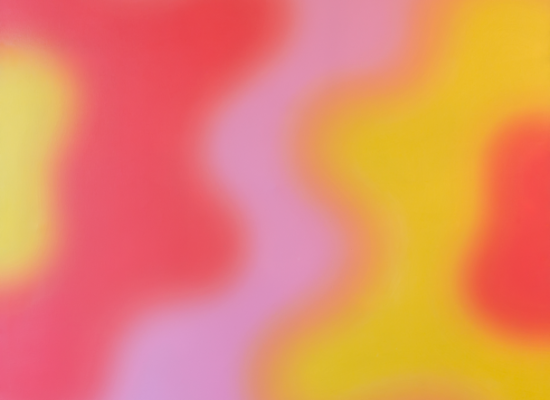Color rarely feels so alive. In Wojciech Fangor’s solo show, curated by de Pury and de Pury at London’s opulent Georgian townhouse 3 Grafton Street, it pulsates, almost bounces from canvas to canvas, drawing viewers into its psychedelic frenzy. Each of the 30 abstract paintings is a universe of saturated hues. Sharp lines have been banned. There’s no limit between one tone and the next, just a vibrating zone that takes the eye from one bright shade to another so effortlessly that there’s almost no recollection of a transition.
The strength of this body of work, realized between 1958 and 1974, lies in the most ethereal of techniques: an absolute command of the blur, which turns here into a sort of acid pop sfumato. It makes the entire surface vibrate, and animates Fangor’s circles, waves, and squares. The impression of movement is so striking at times that it looks as if the pigment is dancing on the picture plane, permeating the space that separates viewer and canvas. The ensemble is a joyfully riotous inversion of traditional perspective: infectious, unsettling, exhilarating.
While all the works presented are abstract oil paintings in the traditional sense, space is very obviously one of Fangor’s prime concerns. Pieces such as the yellow square suspended in space of B111 (1966) or the deep aquamarine and emerald M37 (1967) have something of a James Turrell Space Division Construction: a few steps closer and you could walk in. Other works, such as the dark burgundy M38 (1968), nod towards Mark Rothko. The black and white waves of M33 (1970) are like a softer take on Bridget Riley’s Op Art.
These resonances are not coincidental. Fangor, who was born in Poland in 1922, was at the forefront of several key trends of the mid and late 20th century. His early career was shaped by both the tragic events of WWII and the legacy of modern giants such as Pablo Picasso, Henri Matisse, and Vincent van Gogh (their influence on Fangor can be seen in a touching selection of drawings presented at 3 Grafton St). After the war, Fangor became a successful Socialist Realist painter, celebrated for works such as Figures (1950) and Korean Mother (1951).
This period saw the beginning of Fangor’s friendship with several architects, which spurred his interest in space as artistic material. In 1958, Fangor created A Study of Space, a large environment—the first in Poland—composed of paintings displayed on easels, forcing the viewer to weave her way through his abstractions. The installation landed him an invitation to exhibit at the Stedelijk Museum in Amsterdam and in the US, where Fangor lived from the mid-1960s to the late-1990s.
In America, the artist became an influential teacher and celebrated proponent of Op Art, showing affinities with the investigations of the Californian Light and Space movement. Fangor was very much part of the New York intelligentsia. He was in contact with the likes Richard Artschwager and Josef Albers, designed a stage set for legendary choreographer Martha Graham, and in 1970 had a solo show at the Solomon R. Guggenheim Museum in New York—the first Polish artist to receive the accolade.
But while Fangor was supported by the New York Times critic John Canaday, the show didn’t get the response the artist might have hoped. In a recent interview, he said: “For the American public the exhibition was too late to generate enough attention. Op Art was en vogue in 1965, not in 1970.” In 1998, after a long period of retirement in the States, which saw his return to figuration, Fangor moved back to Poland, where he still lives.
Now in his 90s, the artist is something of national hero in his home country. In the last few years, his work has started to be rediscovered. De Pury and de Pury’s Fangor exhibition feels like the beginning of an official rehabilitation, a call to acknowledge the extraordinary production of an artist who is yet to receive the international recognition he deserves. As Albers said when he visited Fangor’s 1967 Chalette Gallery show: “hat’s off.”
